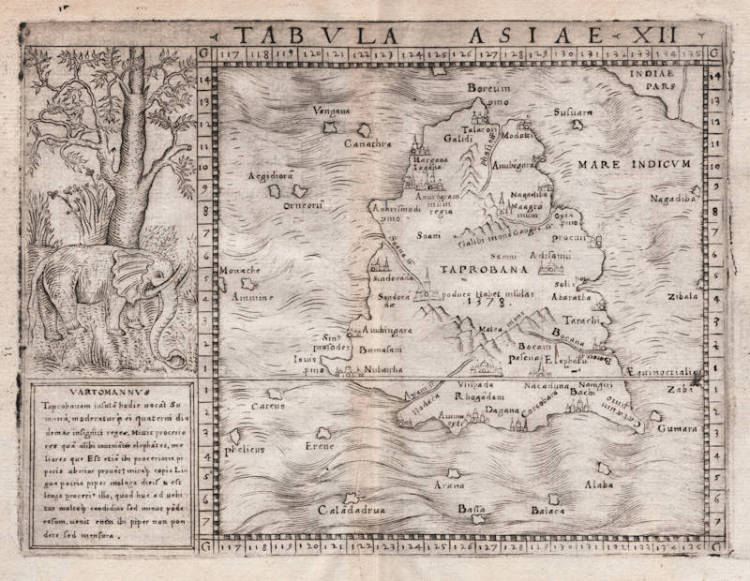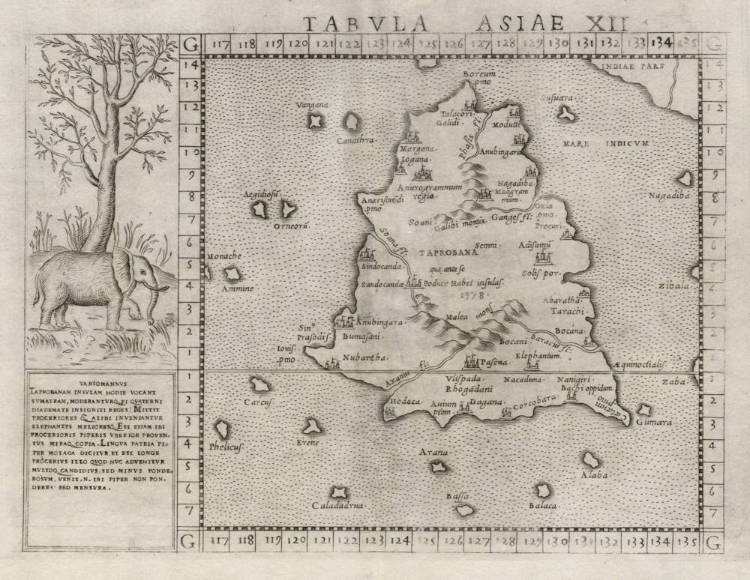Leen Helmink Antique Maps
Antique map of Ceylon by Jodocus Hondius
Stock number: 18753
Zoom ImageCartographer(s)
Jodocus Hondius (biography)
Title
Ins. Ceilan quae incolis Tenarisin dicitur
First Published
Amsterdam, 1606
This Edition
1606 or later
Size
34 x 50 cms
Technique
Condition
mint
Price
$ 1,250.00
(Convert price to other currencies)
Description
Jodocus Hondius superb map of the island of Ceylon, first issued in the 1606 Mercator-Hondius series of atlases. As mentioned in the lower right cartouche, the map was designed by Petrus Plancius. The toponyms leave no doubt that the map is based on Portuguese sources. North is to the left of the map.
The map is the original copperplate that was engraved by Jodocus Hondius the Elder for inclusion in the Mercator-Hondius series of atlases, first published in 1606.
For reasons unknown, in 1638 the map was replaced by a re-engraved copperplate that is similar far less decorative and less skillfully executed, under publishers Johannes Jansson and Henricus Hondius.
van der Krogt 8380.1A:1.
Jodocus Hondius (1563-1612)
Jodocus Hondius the Younger (son) (1594-1629)
Henricus Hondius (son) (1597-1651)
"Jodocus Hondius the Elder, one of the most notable engravers of his time, is known for his work in association with many of the cartographers and publishers prominent at the end of the sixteenth and the beginning of the seventeenth century.
A native of Flanders, he grew up in Ghent, apprenticed as an instrument and globe maker and map engraver. In 1584, to escape the religious troubles sweeping the Low Countries at that time, he fled to London where he spent some years before finally settling in Amsterdam about 1593. In the London period he came into contact with the leading scientists and geographers of the day and engraved maps in The Mariner's Mirrour, the English edition of Waghenaer's Sea Atlas, as well as others with Pieter van den Keere, his brother-in-law. No doubt his temporary exile in London stood him in good stead, earning him an international reputation, for it could have been no accident that Speed chose Hondius to engrave the plates for the maps in The Theatre of the Empire of Great Britaine in the years between 1605 and 1610.
In 1604 Hondius bought the plates of Mercator's Atlas which, in spite of its excellence, had not competed successfully with the continuing demand for the Ortelius Theatrum Orbis Terrarum. To meet this competition Hondius added about 40 maps to Mercator's original number and from 1606 published enlarged editions in many languages, still under Mercator's name but with his own name as publisher. These atlases have become known as the Mercator/ Hondius series. The following year the maps were reengraved in miniature form and issued as a pocket Atlas Minor.
After the death of Jodocus Hondius the Elder in 1612, work on the two atlases, folio and miniature, was carried on by his widow and sons, Jodocus II and Henricus, and eventually in conjunction with Jan Jansson in Amsterdam. In all, from 1606 onwards, nearly 50 editions with increasing numbers of maps with texts in the main European languages were printed."
(Moreland and Bannister)


